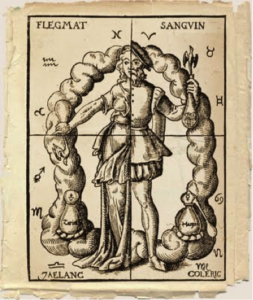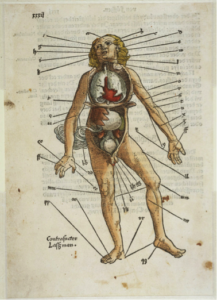By Jared Eckman (Guest Contributor)

Depiction of the humors.
Few biological processes in humans are as specific to a single sex as menstruation. It is distinctly female with no equivalent in males. However, past theories concerning medicine and gender did not always hold this seemingly apparent opinion. In the early modern era, when Western medical thinking still considered differences between the sexes to be somewhat fluid, many physicians believed men had experiences analogous to female menstruation. Bleedings in males, whether pathological or induced by clinical practices, were thought to rid the body of excess and potentially dangerous blood. To explain such observations, we must first explore the factors that shaped medical thought during this period.
Humorism
When most people think of archaic medical practices that have been abandoned for centuries, blood letting quickly comes to mind. What drove bloodletting’s prevalence and acceptance for over a millennium? The idea that a balance of humors achieves good health, descended from the enduring influence of the Greek physician Galen, directly led to the ubiquitous endorsement of this practice. Humorism, which originated with Hippocrates and was later taken up by Galen, posits the existence of four bodily fluids, or humors: black bile, yellow bile, phlegm, and blood. If an imbalance occurs, illness ensues. Therefore, to restore the health of the patient, blood was drawn from the body in an effort to achieve equilibrium. Menstruation was often conceptualized as a similar but natural means of ridding the body of excess blood. However, the question of why females, and not males, menstruate still stands.

The various locations for bloodletting.
Male Heat and Female Coolness
Explanations for menstruation were rooted in beliefs concerning male heat and female coolness. Since it was believed that males generated a significant amount of heat–another principle derived from Galen–they would thus be able to burn off the excess materials that women rid of during menstruation. Since females were thought cooler, they were unable to burn excess blood. However, certain males did not generate sufficient heat to return the humors to a desirable balance and must therefore remove excess blood through other means.
Herein lies the basis for reports of male menstruation. For example, the Swiss anatomist Albrecht von Haller, known as “the father of modern physiology,” attributed nosebleeds in males to a physiological attempt to dispel of excess blood. In girls, this fluid found “a more easy vent downward,” as he put it. The belief that male menstruation rids the body of unwanted, illness-inducing blood is also seen in the writings of several 17th century Spanish physicians. Mixing anti-Semitism with science, they claimed that Jewish males menstruate to rid the body of unclean blood in an attempt to demonstrate the racial impurity of Jews. Although these accounts come from a place of prejudice, they nonetheless demonstrate the prevailing early modern belief in male menstruation and its role in ridding the body of unwanted blood.
Bibliography
Beusterien, J. L. “Jewish Male Menstruation in Seventeenth-Century Spain.” Bulletin of the History of Medicine, vol. 73 no. 3, 1999, pp. 447-456.
Laqueur, Thomas Walter. Making Sex: Body and Gender from the Greeks to Freud. Cambridge, MA: Harvard UP, 1990.
Wiesner, Merry E. Women and Gender in Early Modern Europe. Cambridge: Cambridge UP, 1993.
 Jared Eckman is a junior at Vanderbilt University in Nashville, Tennessee. He majors in Biological Sciences and French and will study in Aix-en-Provence during the spring of 2017. His primary interests include neuroscience, philosophy of medicine, and French literature.
Jared Eckman is a junior at Vanderbilt University in Nashville, Tennessee. He majors in Biological Sciences and French and will study in Aix-en-Provence during the spring of 2017. His primary interests include neuroscience, philosophy of medicine, and French literature.
